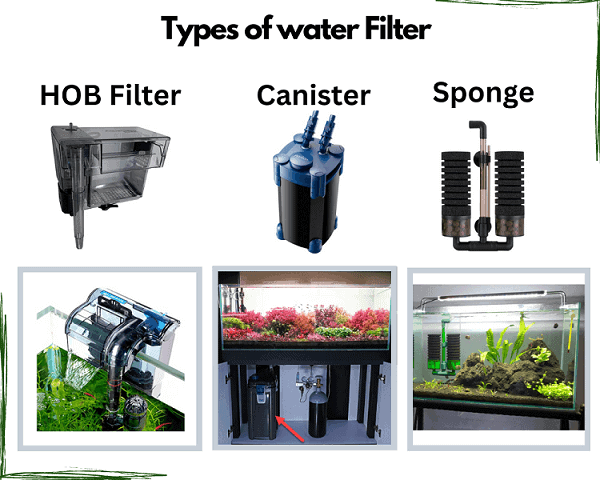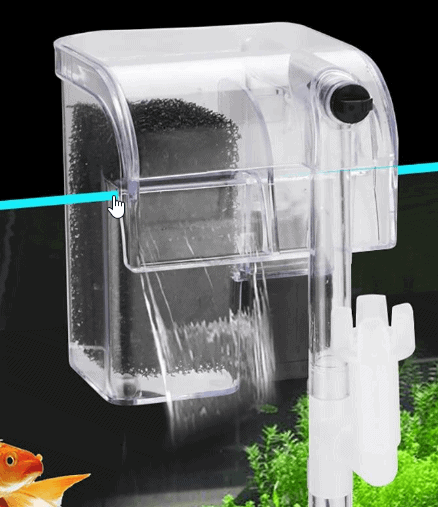Fish Tank Filter
Fish Tank Filter is a common topic discussed among aquarists or those new to the aquarium world.
This article will cover types of filtration, why water filtration is needed, types of fish tank filters, how they work, and some recommendations.
I will go deeper into these five types of fish tank filters:

Table of Content
What is water filtration in a fish tank?
Water filtration in a fish tank is the continuous process through which the water in the tank is cleaned and renewed, removing debris and other organic compounds harmful to the system.
This is achieved through a filter (with different layers) that is an equipment made exactly for this purpose, which must be well chosen by the aquarist.
It keeps the aquarium healthy, beautiful, and safe for fish and plants.
Why is water filtration necessary?
Water Filtration is necessary because it removes or reduces toxic waste, unwanted particles, and other dissolved chemical components produced by fish feces, decaying materials, and uneaten food.
An inefficient filtration system allows these residues to decay and raise the ammonia level in the water, which is highly toxic to your fish, snails, and shrimps (learn more about ammonia here).
Maintaining water quality is critical, and this is where the importance of the fish tank filtration comes in.
Types of filtration (inside the filter)
There are 3 types of filtration in freshwater tanks: mechanical, biological, and chemical.

Mechanical Filtration
Mechanical filtration physically collects particles such as waste and food leftovers in the water (inorganic as, for example, something that falls into the water and organic like, for example, plant pieces, algae, food).
This type of filtration uses physical media, such as sponges, to sift waste from the water.

Different mechanical filtration media will trap particles of various sizes.
Mechanical filtration is usually the first stage of the filter, retaining larger residues, filtering the water for the next filtration steps, and thus preventing clogging.
The Mechanical filter leaves the water visibly cleaner, which is why many people believe that the filter is working properly.
Still, they forget or don’t know about the biological filtration and chemical issue (ammonia) that may harm their fish’s health. I will talk about this later.
It is crucial to maintain your media (clean or replace them with new ones) weekly or every 15 days, depending on how many fish you have in your tank.
Maintenance is vital to prevent issues with water quality as residues retained in filters begin to trigger chemical processes, releasing toxic compounds such as ammonia. That is why we recommend checking your water filter when your ammonia increases.
Mechanical filtration is the first stage of the entire tank filtration process.
Mechanical filtration will trap the bigger residues, not the smaller ones or chemical waste.
Biological Filtration
Biological filtration involves the breakdown of waste by beneficial bacteria (they eat waste).
These bacteria drive “the nitrogen cycle,” which is sometimes called the Ammonia Cycle. They help keep your water clean by ” eating” these small particles. Learn more in this article.
These beneficial bacteria live and multiply in many places, such as the biological filtration media (picture below), tank substrate, water, and rocks. They lodge on any surface, such as the substrate and media.

You have to breed and grow them before you put fish in your tank or whenever you believe you killed them by mistake. Sometimes, you have them already, but you need more.
The process of breeding and growing these bacteria in your fish tank is called Cycling your Aquarium. Check out this article to learn how to breed and develop them.
There is a whole chemical process to maintain the balance of the aquarium ecosystem. It’s called the Nitrogen Cycle.
Chemical filtration
Some aquarists think chemical filtration is not an essential part of the filtration system as it is typically used to remove odor or color from the water. In these cases, chemical filtration addresses the symptoms of an issue. They usually say you have to handle its cause.
Chemical filtration primarily relies on activated carbon to remove dissolved waste from water at a molecular level that mechanical filtration can’t handle.
Activated carbon retains the molecules through their micropores, removing odors and gases from the water.

Unfortunately, chemical filtration neutralizes some medicines and should be discontinued while medications are being administered.
Some aquarists don’t use it regularly because it can remove some beneficial substances for fish, invertebrates, and plants.
I recommend these activated carbon bags! They are amazing.

Types of Filters
There are several types of fish tank filters on the market with different brands and models, each with advantages and disadvantages.
We can classify the types of filters into two categories: external and internal filters.
External filters usually have the highest value but with the advantage of being easier to maintain and, in some cases, having greater internal space.
On the other hand, internal filters have an advantage in terms of costs, but they may not please aesthetically, in addition to taking up space inside the fish tank.
Water filters are classified into 4 main types:

Hang On Filter
The hang-on filter (HOB) works externally, where water circulates through it and returns to the tank through pumping or gravity. It is the most common fish tank filter.
They don’t take up much space, and there are several brands and models of this type of filter. They are the best cost-effective filter.
In general, all models have a refill containing mechanical/biological/chemical filtration, but it is possible to customize it according to the fish tank’s needs.

Canister Filter
The canister filter involves a large reservoir where all filter elements will be accommodated in drawers or shelves.
It is installed outside the fish tank, freeing up more space for the fish and plants. Some compact versions are positioned inside the aquarium – both types are excellent).
This is the type of filter I prefer as you can accommodate more media on it, you can easily add stuff, it is easier to clean, and it doesn’t take space inside your tank.

Sump filter
Canister filters usually come with different media types that can easily be cleaned, reused, or replaced. Its customization is unparalleled, as any media can be placed in the drawers.
This is the best aquarium filter for large tanks !
Sumps are fish tank water filters for large systems (usually at least 75 gallons) or tanks with large fish.
Sumps are based on an additional reservoir. The water from the main tank is collected through siphoning or gravity, passing through the reservoir formed with several filter elements, separated by sections, and returning the water through pumping to the main tank.
This additional reservoir should be at least 20% of the volume of the main tank.
One of the main advantages of this type of filter is the ease of maintenance.
Sumps increase system volume and are highly customizable, especially when you make your own.

Sponge filter
Sponge filters are another cheap and easy to use and make a water filter.
That’s right, you can make one using easy-to-find accessories.
It is an excellent mechanical filter and works well as a biological filter. It is widely used in quarantine tanks because its design allows easy installation and removal.
Its operation is simple. The air pump sends air to the diffuser stone, which releases it in tiny bubbles, which rise to the surface, creating a current that makes the water pass through the sponge, filtering and oxygenating it.
The filter absorbs water through the sponge and expels it through the chimney due to the current formed by the air bubbles that rise.

Reverse Osmosis filters for fish tank water
Reverse Osmosis systems are a group of filters that remove all traces of minerals from tap water. You can use RO water when making your fish tank or during water changes.
They are not aquarium filters, but I decided to mention them as many of us have one to filter the water we use in our tank when doing water changes.

I like to use this RO kit from AquaticLife – it costs about ($70).
To dig into how reverse osmosis filters work, look at this article.
The U.S. Food & Drug & Administration also has an excellent article that can be found here.
Which are the most common aquarium filter types?
The most common aquarium filter is the Hang On Filter.
They only take up a little space, and there are several brands and models of this type of filter. They are the best cost-effective filter.
Learn more about Hang On Filters here.
What is the best fish tank filter?
The best and most common aquarium filter is the Hang On Filter (again).
They take up little space, there are several brands and models, they are easy to clean, and they are not expensive.
They are the best cost-effective filters.
Learn more about Hang On Filters here.
Tell me about the betta fish tank with filter.
People will say betta fish don’t need a water filter because they are used to living in stagnant and dirty water. The problem is that your tank is not a natural and complete environment like a pond or lake with an entire ecosystem.
Bettas need a water filter as food scraps, fish urine, and feces become Ammonia, which is toxic and must be removed from the water.
Water filtration, mainly biological filtration, is essential even in a betta fish tank to keep ammonia levels under control (read more about biological filtration here and how to grow your good bacteria here).
Read more about betta fish tank water filter here.
What is the best filter for Betta?
The best 2024 filter for a betta fish tank is the Fluval C2.
It is bigger than the others, so you have additional space to put more biological media, foam/mechanical filter in the same device.
Read more here.
What is RO water filter for an aquarium?
RO water filter or Reverse Osmosis water filter are a group of filters that remove all traces of minerals from tap water.
They are not aquarium filters, but they help to prepare the water to be used in your fish tank.
Is there an external water filter for the aquarium?
Yes. There is an external fish tank water filter called canister.
They are typically a large reservoir where all filter elements will be accommodated in drawers or shelves
What are the 3 types of aquarium filtration?
The 3 types of aquarium filtration are Mechanical filtration, Biological filtration and Chemical filtration.
Mechanical filtration physically collects particles such as waste and food leftovers in the water (inorganic as, for example, something that falls into the water and organic like, for example, plant pieces, algae, food).
Biological filtration involves the breakdown of waste by beneficial bacteria (they eat waste).
Chemical filtration that is, by the way, not an essential part of the filtration system as it is typically used to remove odor or color from the water. In these cases, chemical filtration addresses the symptoms of an issue. They usually say you have to handle its cause.
Conclusion
Canisters are the best option for Fish Tank Water Filter as you can accommodate different types of media in different orders, you can easily add media if needed, and it is easier to clean them up. As they are outside of the tank, they are also more beautiful.
I hope you liked this article. My intention is to share my experience. I am always open to learning, so I would love to learn or help if you have suggestions or questions.
By the way, I suggest you look at this other article where I explain Water Parameters like pH, Ammonia, Nitrates, Hard Water, etc.
